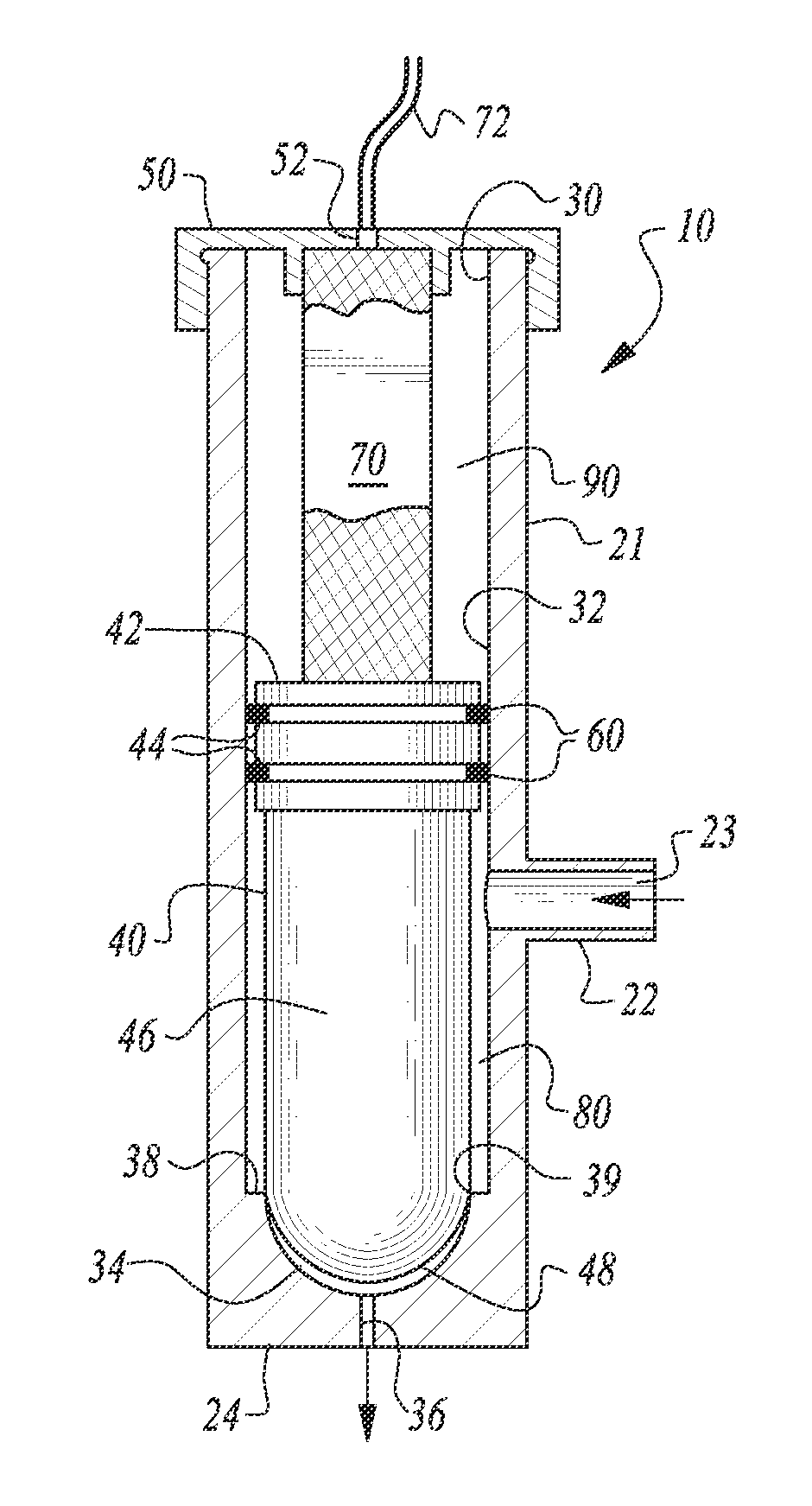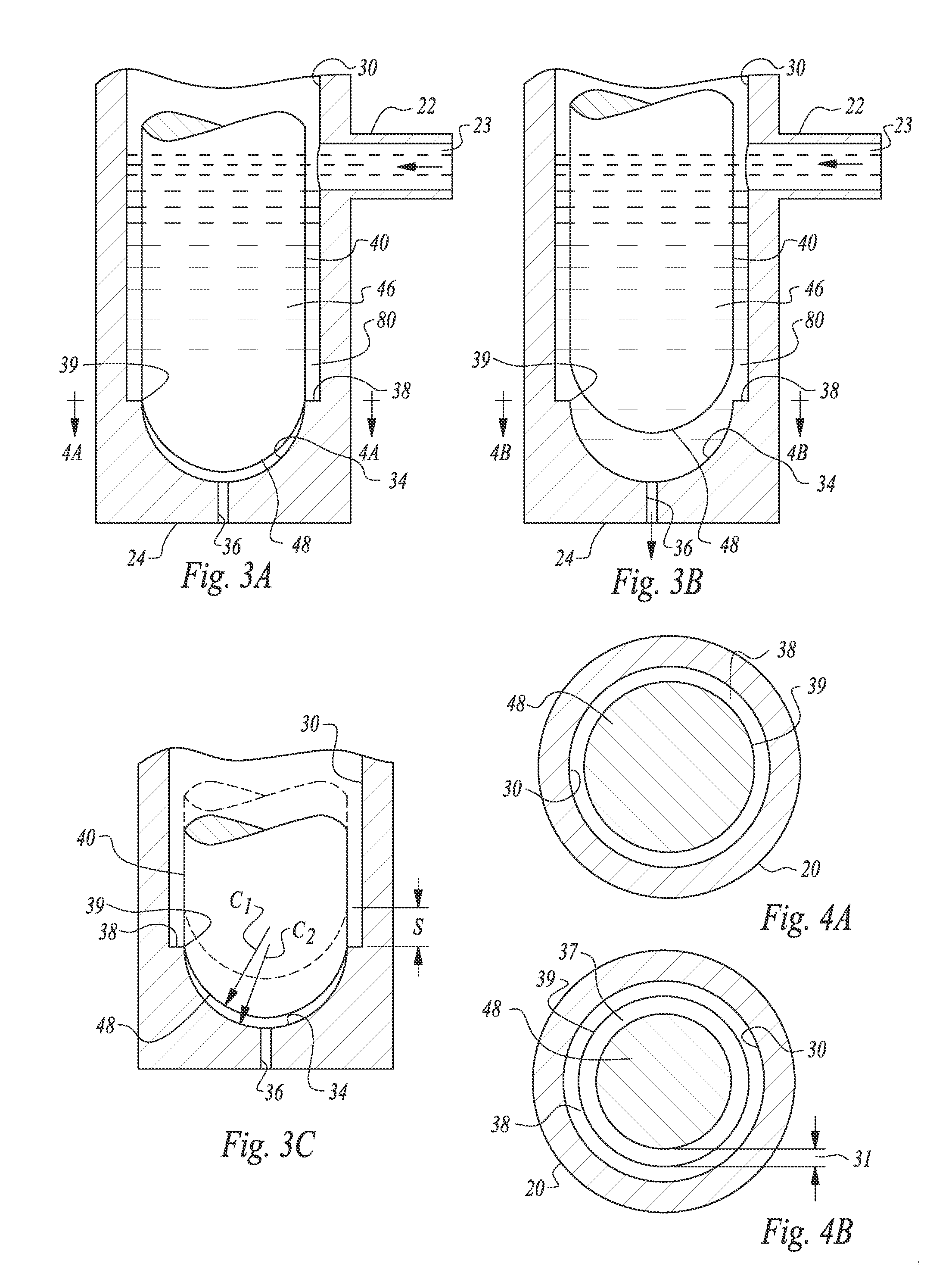Current fuel injectors suffer from an inability to operate at high frequencies, which limits their applicability to advanced and emerging engine designs which operate at higher frequencies typically described in
revolutions per minute (RPM).
In addition, current injectors cannot easily vary the
fuel delivery profile during an injection /
combustion cycle, which further limits their inclusion in more sophisticated combustion configurations, particularly those operating at higher frequencies.
Furthermore, current injector configurations have a response
lag associated with various factors, including a displacement amplification requirement, which impedes higher frequency operation.
Finally, previous injectors which rely on piezoelectric actuation cannot directly actuate the flow control member that allows fuel to pass through an injection orifice into a
combustion chamber due to an inability to move the flow control member a distance off its seat to allow fuel to flow at a selected rate.
This multi-step process of indirect hydraulic actuation and amplification creates an inherent limit to the operational frequency of the injector due to intrinsic response
lag.
Consequently, these
dual stage piezoelectric injectors generally will not support the higher frequency operations of advanced and emerging engine technologies.
The shape of the pin results in over-balanced pressure, causing the pin to be seated on the orifice in a closed position.
When a piezoelectric stack is used in the above manner, the overall
system is mechanically and operationally more complex.
Amplification of the displacement of the stack is required due to the extremely limited displacement of a piezoelectric stack relative to the displacement required to lift the pin a distance off its seat to enable the flow of fuel.
This response lag impedes the ability of a hydraulically amplified injector, even those using
piezoelectric actuators, from operating at higher frequencies, such as those that might be required for pulse
detonation engines or racing engines
Present injector actuation methods have other limitations.
Unfortunately, this approach creates an even higher operational demand on the injector apparatus due to the multiplication of actuation cycles during each injection cycle.
Piloted valves require much less power to control, but are noticeably slower.
Consequently, heretofore, this limited displacement has forced piezoelectric actuation mechanisms in fuel injectors to be used only in an amplification configuration rather than to directly actuate the valve member that controls the flow of fluid through the valve.
Necessarily, the prior piezoelectric injector configurations that rely on displacement amplification do not deliver direct actuation.
Unfortunately, the inclusion of this mechanical feature introduces the limitation of a mechanical spring variable that may limit
high frequency operation of the
actuator and
longevity.
Additionally, this flextensional approach used to increase displacement also results in a decrease in the maximum force that may be applied by the stack.
Each of these references fails to provide a solution for use of a piezoelectric actuator having minuscule displacement wherein the piezoelectric actuator directly drives the flow control member of the injector.
Additionally, and in further detail, these references suffer from one or more of the following disadvantages, which will tend to impede
high frequency operation and limit optimization throughout each combustion cycle to create
maximum efficiency.
These disadvantages include: (1) indirect actuation; (2) partial spring actuation; (3) complex mechanisms with a plurality of components and parts; (4) operation only in a fully-open or fully-closed position; (5) desired displacement distances which would require prohibitively long piezoelectric stacks; (6) one or more boosters to achieve opening forces; (7) actuating mechanisms unable to accommodate sufficient displacement; (8) inclusion of spring elements likely to induce
valve float at higher frequency operation; (9) indirect actuation via hydraulic amplification resulting in lag and
hysteresis; (10) no
analog control of valve position; (11) inability to provide refined prestress on the piezoelectric stack to avoid placing it in tension; and (12) inability to adapt in real time to changing operating parameters or engine performance requirements.
Consequently, these other attempts do not provide direct actuation.
Furthermore, Nakamura et al. does not describe a method for prestressing the piezoelectric stack.
General operation of the injector is either fully open or fully closed, with no ability to provide variable injection rates.
Additionally, it is unclear how the piezoelectric stack described by Nakamura et al. would provide sufficient displacement or contraction to move the needle sufficiently to unplug the injection hole, even with the inclusion of a supplementary spring.
The system described by Boecking is a complex mechanism with insufficient displacement to move the pin sufficiently to support high volume
fuel delivery.
Additionally, Boecking's injector relies on the movement of a small
needle valve, which will inhibit the ability to deliver flow at higher rates.
Stoecklein's approach does not address issues of response lag nor
adaptation to operate at high frequencies.
Furthermore, although limited two-stage control is described, highly granular, essentially
analog control is not supported by Stoecklein's injector system.
Hence, even though the injector may improve firing for opening and closing to address flow profile, it fails to provide
analog control of the valve position to deliver highly granular control of the flow profile throughout each combustion / injection cycle.
Thus, the injector of Rauznitz et al. fails to provide direct actuation of the valve control member, limiting application in high frequency injection scenarios, and, fails to provide highly granular control of the fuel flow profile, limiting use, for example, in pulse
detonation engines.
Finally, the injector is designed to accommodate only smaller injector needles and would not support large injector sizes to accommodate increased fuel flow.
Precise control and analog positioning of the nozzle valve needle throughout its displacement is not possible.
Furthermore, the injector uses springs to bias the valve element into a closed position, which introduces complexity and will cause the injector to suffer float at higher frequency operation.
This mechanism adds complexity to the injector.
Furthermore, the Boecking injector is limited to operation in two discrete
modes: on and off.
The inclusion of the envelope and spring mechanisms in the injector of Takahashi introduces the problem of
valve float at higher operational frequencies, along with indirect actuation limitations.
 Login to View More
Login to View More  Login to View More
Login to View More 


